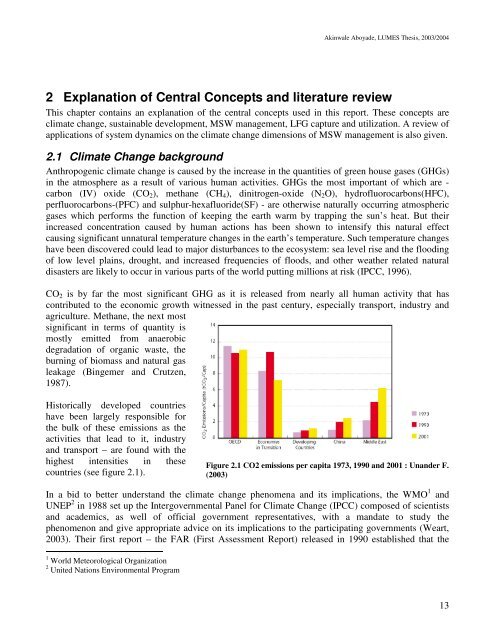Wale Aboyade's thesis - lumes
Wale Aboyade's thesis - lumes
Wale Aboyade's thesis - lumes
Create successful ePaper yourself
Turn your PDF publications into a flip-book with our unique Google optimized e-Paper software.
Akinwale Aboyade, LUMES Thesis, 2003/2004<br />
2 Explanation of Central Concepts and literature review<br />
This chapter contains an explanation of the central concepts used in this report. These concepts are<br />
climate change, sustainable development, MSW management, LFG capture and utilization. A review of<br />
applications of system dynamics on the climate change dimensions of MSW management is also given.<br />
2.1 Climate Change background<br />
Anthropogenic climate change is caused by the increase in the quantities of green house gases (GHGs)<br />
in the atmosphere as a result of various human activities. GHGs the most important of which are -<br />
carbon (IV) oxide (CO 2 ), methane (CH 4 ), dinitrogen-oxide (N 2 O), hydrofluorocarbons(HFC),<br />
perfluorocarbons-(PFC) and sulphur-hexafluoride(SF) - are otherwise naturally occurring atmospheric<br />
gases which performs the function of keeping the earth warm by trapping the sun’s heat. But their<br />
increased concentration caused by human actions has been shown to intensify this natural effect<br />
causing significant unnatural temperature changes in the earth’s temperature. Such temperature changes<br />
have been discovered could lead to major disturbances to the ecosystem: sea level rise and the flooding<br />
of low level plains, drought, and increased frequencies of floods, and other weather related natural<br />
disasters are likely to occur in various parts of the world putting millions at risk (IPCC, 1996).<br />
CO 2 is by far the most significant GHG as it is released from nearly all human activity that has<br />
contributed to the economic growth witnessed in the past century, especially transport, industry and<br />
agriculture. Methane, the next most<br />
significant in terms of quantity is<br />
mostly emitted from anaerobic<br />
degradation of organic waste, the<br />
burning of biomass and natural gas<br />
leakage (Bingemer and Crutzen,<br />
1987).<br />
Historically developed countries<br />
have been largely responsible for<br />
the bulk of these emissions as the<br />
activities that lead to it, industry<br />
and transport – are found with the<br />
highest intensities in these<br />
countries (see figure 2.1).<br />
Figure 2.1 CO2 emissions per capita 1973, 1990 and 2001 : Unander F.<br />
(2003)<br />
In a bid to better understand the climate change phenomena and its implications, the WMO 1 and<br />
UNEP 2 in 1988 set up the Intergovernmental Panel for Climate Change (IPCC) composed of scientists<br />
and academics, as well of official government representatives, with a mandate to study the<br />
phenomenon and give appropriate advice on its implications to the participating governments (Weart,<br />
2003). Their first report – the FAR (First Assessment Report) released in 1990 established that the<br />
1 World Meteorological Organization<br />
2 United Nations Environmental Program<br />
13

















